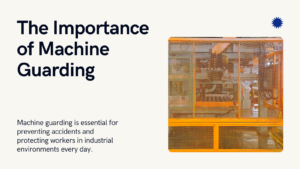In the industrial world, machines are the heartbeat of productivity. They shape, cut, weld, assemble, and transport—driving efficiency across factories and workshops. But with such power also comes risk. Moving gears, sharp blades, rotating shafts, and high-speed conveyors can pose serious hazards if not properly managed. That is why machine guarding has become one of the most vital components of workplace safety.
Machine guarding is the practice of installing protective devices—such as barriers, enclosures, or interlocks—around machinery to keep workers safe from moving parts and other dangers. Beyond simply following regulations, investing in effective guarding ensures that employees feel secure, operations remain uninterrupted, and businesses uphold their duty of care.
Why Machine Guarding Is Essential
 Industrial history has shown that unguarded machinery is one of the leading causes of workplace injuries. Common accidents include amputations, crushing injuries, and severe lacerations. Each of these incidents not only affects workers but also disrupts business operations through downtime, investigations, and potential legal consequences.
Industrial history has shown that unguarded machinery is one of the leading causes of workplace injuries. Common accidents include amputations, crushing injuries, and severe lacerations. Each of these incidents not only affects workers but also disrupts business operations through downtime, investigations, and potential legal consequences.
Machine guarding serves three key purposes:
-
Protecting Workers – The most obvious benefit is reducing the risk of contact with dangerous parts. Guards act as a physical barrier between people and hazards.
-
Regulatory Compliance – Occupational Safety and Health Administration (OSHA) standards in the U.S. and PUWER regulations in the U.K. require machines to be safeguarded. Failure to comply can result in fines, lawsuits, and reputational damage.
-
Boosting Confidence & Productivity – When employees feel safe, they are more focused and efficient, leading to improved overall productivity.
In essence, machine guarding is not just a technical necessity; it is also a strategic investment in the workforce and the business itself.
Stallion Guards: A Reliable Safety Partner
For organizations looking for robust safety solutions, Stallion Guards has positioned itself as a trusted name. Their products focus on delivering a balance between safety, durability, and usability, making them a preferred choice across multiple industries.
Features That Stand Out
-
360° Zero-Contact Design – Ensures no accidental access to moving parts.
-
Ergonomic and User-Friendly – Guards are lightweight, easy to install, and allow visual inspection through perforated panels.
-
Durability – Built from heavy-duty, powder-coated steel, ensuring long service life even in challenging environments.
-
Unique Identifier (UIN) – Every unit is traceable, simplifying audits, maintenance, and compliance checks.
The Advantages
-
Improves workplace safety with comprehensive coverage
-
Saves time through fast installation and simple removal
-
Supports compliance with global safety standards
-
Reduces maintenance delays with inspection-friendly designs
Considerations
-
Customization Needs – Unique machines may require specialized designs.
-
Initial Investment – Premium quality may cost more upfront compared to generic alternatives, but long-term benefits outweigh the cost.
With Stallion Guards, safety doesn’t come at the cost of efficiency. Instead, their design philosophy ensures that protection enhances workflow rather than hindering it.
Types of Machine Guarding
Machine guarding is not a one-size-fits-all solution. Different industrial settings require different guarding techniques:
-
Fixed Guards – Permanent enclosures that prevent access to hazardous parts.
-
Interlocked Guards – Automatically stop the machine when the guard is opened.
-
Adjustable Guards – Can be repositioned to suit various processes.
-
Perimeter Guards – Fencing systems that enclose larger equipment, robots, or automated cells.
Best Practices in Guarding:
-
Guards must not create new hazards (e.g., sharp edges or pinch points).
-
They should be securely attached to withstand vibration and pressure.
-
Machines with movable guards should not restart automatically when reopened; a manual reset is recommended.
-
Regular inspections should be conducted to ensure guards remain effective.
Machine Guarding in the Age of Automation
The modern workplace is evolving. Robotics, AI, and smart monitoring systems are now integral to manufacturing. With greater automation, safety measures must adapt too.
This is where machine guarding integrates with technology. Physical guards protect against immediate contact risks, while digital tools enhance predictive safety. For example, AI-driven workplace monitoring can identify unsafe behaviors or machine malfunctions before they cause accidents. The combination of traditional safety hardware with modern AI insights ensures industries stay productive and compliant in the face of rapid change (CoreGuideAI).
This blending of physical and digital safety represents the future—guarding workers not just against physical harm, but also ensuring a proactive approach to risk management.
Frequently Asked Questions
Q1. What is machine guarding?
Machine guarding is the installation of protective barriers around machines to prevent accidents caused by direct contact with dangerous parts.
Q2. What makes Stallion Guards unique?
They combine ergonomic design, durable build, and traceability features (UIN) that simplify compliance and maintenance.
Q3. Do machine guards slow down production?
No. In fact, they streamline workflow by reducing accidents, downtime, and lengthy maintenance interruptions.
Q4. How often should guards be inspected?
Monthly inspections are recommended, but facilities with high machine usage may require more frequent checks.
Q5. Are Stallion Guards compliant with international standards?
Yes. They are designed in line with OSHA, PUWER, and ISI safety requirements, making them reliable across global operations.
Final Thoughts
Machine guarding is not just a compliance requirement—it is a fundamental commitment to worker safety and organizational efficiency. By preventing accidents, ensuring legal compliance, and creating a culture of trust, it forms the backbone of industrial safety programs.
Stallion Guards has taken this responsibility further by creating products that are not only strong and reliable but also user-friendly and technologically smart. Their guards protect without slowing down operations, ensuring businesses can achieve safety and productivity together.
In a world where industrial growth is tied to both efficiency and responsibility, machine guarding stands as a clear reminder: protecting people is the first step in protecting progress.

